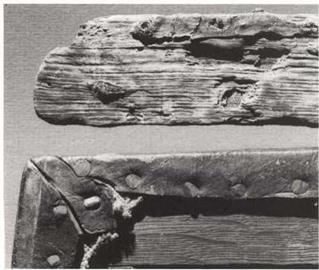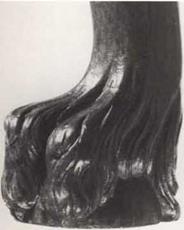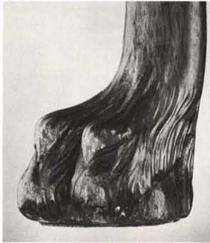The excavation of the Anthony I lay shop by Ivor Noel I lume, Colonial Williamsburg’s resident archaeologist, was the most successful of several cabinetmaking sites examined in Williamsburg. Many artifacts w ere recovered, yielding a remarkable quantity of information regarding the building and its activities, and providing the main thrust of Noel I lume’s Williamsburg Cabinetmakers—the Archaeological Evidence (see footnote 48). This booklet gives an account of the excavation and illustrates and discusses many of the hundreds of artifacts from that site. The abundance of material contrasts markedly w ith the lack of evidence yielded by the excavation of the site where Peter Scott’s shop stood for over forty years.
Several artifacts excavated at the I lay site provide firm evidence for identifying production there. The most important is an unfinished leg intended for a mahogany easy chair (fig. 65). Corresponding to this is a complete easy chair w ith identical construction and similar trumpet-shaped pad feet. It was exhibited in the Virginia Museum exhibition Furniture of the Old South in 1952.73 Although that example had rounded knees, it probably represents another version from this same shop. It is unfortunate that the chair’s current location is unknown, for closer study would probably be extremely revealing.
Although the leg excavated at the 1 lay site w as originally thought to have been discarded from a repaired daybed, three aspects prove that it was intended for an easy chair and that it was in an unfinished state when thrown away.74 The side – mortise in the excavated leg enters at an acute angle (fig. 65b) and contrasts significantly w ith those of a daybed, which by necessity are perpendicular and form square corners. The post above the cabriole is shaped parallel to the angled mortise, thus proving it to be a right front leg. The height of thirteen inches indicates that it w as made for an easy chair rather than a couch. Furthermore, the leg’s intended use on an upholstered piece is verified by the peak at the outer comer of the post, which has been dulled somewhat by decay but is still very apparent. The purpose of the peak w as to help maintain a straight, neat upholstery line on the corner of the chair where its covering was pulled over the rails. The outline of this shaped point is still visible on top of the original seat of the signed Bucktrout chair (fig. 49c).
With the angled mortise indicating that the leg is from a chair, and the point on its top proving that it w as intended to be upholstered, the lack of tacks and tack holes is then substantial evidence to show that


 |
65. Easy Chair lug, excavated at the Anthony Hay site, Williamsburg, П55-П15.
Mahogany.
Height П’А", width 2/h", depth 2 A".
The Colonial Williamsburg Foundation (ace. no. 6099 E. R. 74HH-2S. D).
the leg w as never used on a finished chair. Despite the fact that decay has eroded the piece somewhat, there is sufficient surface remaining without evidence of nails to determine, w ithout question, that this leg was neither finished nor had upholstery nailed to it. There are obvious signs of damage as well, most notably the loss of wood above the lathe-turned foot, on the back of the ankle. This may have been split off during the shaping and, if so, would have been suf ficient reason for discarding the piece.
The mortises of the leg are cut I ‘/* inches below the top of the knee, a feature that causes the knee brackets in the finished piece to overlap the front face of the seat rails. This construction can be seen on two surviving chairs attributed to the I lay shop (figs. 49, 59), on the signed Bucktrout chair (fig. 49), on the Speaker’s chair (fig. 7), and on all the cabriole-leg chairs in the Peter Scott group.
Another leg from the excavation (tig. 66) is in a better state of preservation anti appears to have been cut from similar, tine quality mahogany. The dimensions suggest that it was intended for either a dining or dressing table, although the heaviness of the top section would seem to rule out the latter. It w as in an earlier stage of production than the easy chair leg w hen it w as ruined by the loss of a long section from the center. The evidence of this mishap is well preserved, and clearly show s an area of curly w ood where the workman’s draw knife caught in the cross-grain and lifted out a long splinter.
Although this leg does not provide the constructional information found on the easy chair example, it does provide one of the rarest extant documents of cabinetmaking techniques in the eighteenth century. Originally interpreted as representing an early stage in the formation of a ball-and-claw foot, it actually appears to be an unfinished animal or hairy-paw foot.75 This is somewhat unexpected since the leg is the straight type, and animal feet are normally associated with cabriole legs. Its extreme mass, however, precludes the only other possibility: a pad or a trifid foot.
The identification of this foot’s intended form rests jointly on a knowledge of the production of the paw foot and on the physical evidence of this surviving example. To fully understand the design of a paw foot, however, it is first necessary to discuss the process of creating a ball-and-claw.
A ball-and-claw foot is carved from a squared block (fig. 66c). The bottom of the block is laid out for carving by designating the center and by marking the circumference of the ball with dividers or a compass. The four claws arc then marked at the extreme corners of the square w here they would be formed from the projecting w ood. After the toes are marked, a second compass circle is inscribed w ithin the previous one to designate the base of the ball. With the outlines thus marked, the carver proceeds to cut aw ay the area between the claw s and forms the contour of the ball along the compass lines. After this stage is complete, the contours are continued up and over the top, forming the remainder of the ball and the claw s.
Animal feet are characterized by five toes, in contrast to the four of ball-and-claw feet. In most examples they have four toes crowded together on the front, with a fifth, the fetlock, on the back. Since the animal paw does not utilize all four corners of the roughed-out block, the front and side corners are removed completely in carving (figs. 66a, 66d), thereby necessitating a larger piece of wood than required for a ball-and-claw foot of comparable size. A paw foot could not be effectively carved from a


 |
block of wood designated for a ball-and-claw, for the finished product would be too small and therefore would not project forward from the ankle enough to produce a successful design. The unfinished leg excavated at the I lay site has this extra allow ance for the paw foot and is made from a block of wood that w as originally IV* inches square. The front corner is removed by two distinctive blade cuts (fig. 66a) and the two side corners have also been removed, leaving the back, from which the fetlock w as to be carved, untouched. One side of the roughed-out foot has a series of chisel cuts (fig. 66b), which appear to be the first stage of shaping for one of the large toes. The slight groove formed by these cuts moves up the vertical part of the foot, then turns inward toward the ankle.

 Through a comparison of this unfinished Hay foot and those surviving from the eighteenth century, it is possible to reconstruct the geometric system used to lay out construction lines for carving. First, the center of the square block is determined by making diagonal lines from opposite corners. From the center point, the largest circle possible is inscribed within the base. This circle, how ever, stops short of the back corner, which will eventually form the fetlock. The front and two side corners are then cut aw ay to make the block conform to the arc on the base. The excavated I lay leg clearly represents this state in the process (tig. 66a). At this point it is necessary to inscribe the first full circle on the bottom of the block, which w ill outline the base of the ball on which the paw rests. Only one is needed, rather than the two found on a ball-and-claw. This difference arises since an animal foot usually grasps only the upper third of a ball. By contrast, the ball under a claw foot is larger and more fully rounded, necessitating two circles in its layout. The outer circle establishes the ball s circumference, which is above the base, and the inner circle indicates the segment that rests on the Hoor. With the base circle of the animal foot thus marked, the compass (maintaining the same radial setting) is used to mark the centers of the two front toes. These centers are marked by placing the compass point on the intersection of the diagonal lines w ith the base circle (fig. 66d). I’he center of the two side toes and the fetlock are at the intersection of the diagonal lines and the base circle, and therefore they are perpendicular to each other.
Through a comparison of this unfinished Hay foot and those surviving from the eighteenth century, it is possible to reconstruct the geometric system used to lay out construction lines for carving. First, the center of the square block is determined by making diagonal lines from opposite corners. From the center point, the largest circle possible is inscribed within the base. This circle, how ever, stops short of the back corner, which will eventually form the fetlock. The front and two side corners are then cut aw ay to make the block conform to the arc on the base. The excavated I lay leg clearly represents this state in the process (tig. 66a). At this point it is necessary to inscribe the first full circle on the bottom of the block, which w ill outline the base of the ball on which the paw rests. Only one is needed, rather than the two found on a ball-and-claw. This difference arises since an animal foot usually grasps only the upper third of a ball. By contrast, the ball under a claw foot is larger and more fully rounded, necessitating two circles in its layout. The outer circle establishes the ball s circumference, which is above the base, and the inner circle indicates the segment that rests on the Hoor. With the base circle of the animal foot thus marked, the compass (maintaining the same radial setting) is used to mark the centers of the two front toes. These centers are marked by placing the compass point on the intersection of the diagonal lines w ith the base circle (fig. 66d). I’he center of the two side toes and the fetlock are at the intersection of the diagonal lines and the base circle, and therefore they are perpendicular to each other.
It should be pointed out that many eighteenth – century feet w ere not produced by the use of these two geometric systems, and many appear to have been carved from memory. This is particularly true of ball-and-claw feet. Those that were not laid out show a Hat-sided configuration that is clearly an echo of the square block from which they w ere carved. All the ball-and-claw feet in the Scott group reflect this degeneration, while that of the London example (fig. 17) is made by the geometric system, resulting in a foot of bold, high quality. Paw feet w ere sometimes produced by employing a variation of the ball-and – claw system. In these cases, the side corners of the block were utilized for the two side toes, and only the front corner is completely removed. This procedure produces a paw foot with all of the toes nearly equal in length and lacks the sculptural form of those produced by the geometric system.
Of the paw feet attributed to the I lay shop, those of the Lodge Six chair (figs. 47, 72) were produced by the ball-and-claw method, while the Capitol chair (figs. 46,68) and Lodge Four chair (figs.
59, 70) represent the geometric plan found on the excavated leg. It appears significant that the two chairs that utilize this system date from periods when professional carvers w ere employed in the 1 lav shop. The Lodge Six chair dates in the interim and exhibits a lack of know ledge of the geometric system at a time when no professional carvers are documented there. In light of these circumstances, the excavated leg would seem to date from the period of one of the carvers; either the mid 1750s or between 1774 and 1776. The form of the top of the leg indicates the 1750s, since its massive upper section is quite similar to tables shown in the early Williamsburg group. The association of these legs w ith the I lay shop production thus established, the following illustrations provide a good perspective of the relationship Williamsburg paw feet have to others made in America and Fngland (figs. 68-74).
Among the other significant artifacts from the I lay site, one of the most intriguing is a portion of a slip seat for a chair (fig. 67). Remarkably, it survives w ith a three-inch section of original leather upholstery. The complete slip seat show n beside the excavated example comes from a set of chairs made for the Governor’s Palace (fig. 32) and is upholstered in identical fashion to the discarded example. The most unusual feature seen here is the long tab of leather pulled over the corner and attached underneath with a single wrought nail. The excavated fragment shows this same upholstery technique, and the outline of the original tab is visible. Beneath the nail is a surviving strip of leather. In addition to utilizing the same upholstery technique, both seat frames are oak.
While the excavated slip seat fragment cannot be firmly attributed to the I lay shop, it is solid documentation for this type in Williamsburg and it further supports a local origin for tw o sets of chairs that also have this feature. Both of these have histories in the Governor’s Palace. The slip seat show n here (fig. 67) is attributed to the Peter Scott shop, and the other (fig. 58) is attributed to Edmund Dickinson. The latter piece further verifies the presence of the corner tab upholstery technique in the 1 lay shop during Dickinson’s time there. Together with Scott details that appear on other furniture attributed to Dickinson, this suggests that the technique may have originated in Scott’s shop.
Also recovered from the I lay site is the top section of a chair leg, apparently discarded from a repair. The molding on its top edge compares closely to that on top of the seat rails and legs of the Palace chair attributed to Dickinson (fig. 58). It also occurs in a cruder form on the Jefferson chairs from the Scott group (fig. 30). Although this molding is somewhat standard on chairs from areas outside Virginia, it is rarely encountered on examples from eastern Virginia.
As research continues and other related objects emerge, materials excavated at the Anthony I lay site will undoubtedly continue to furnish important insight into the products of Williamsburg cabinetmakers.
Products of the Hay shop show a diversity of design, quality, and constructional approach that forms a sharp contrast to the consistency of the Scott group. Correspondingly, the various masters of the I lay shop continually advertised for journeymen, while no such advertisements are known from Peter Scott. The conclusion to be reached from this correlation of objects and documents is that the 1 lay shop was operated by masters who were progressive businessmen, willing to contract with various
|
67. Slip Seat fragment excavated at the Anthony Hay Shop. 7 he fragment is here compared to an original slip seat from a chair in the Palace set (fig. 12). Oak, leather, iron. The Colonial Williamsburg Foundation (acc. no. ER 205- 28D). |
|
67a. Slip Seat, fragment. A portion of its leather upholstery survives on the outer edge. Close inspection reveals that a ghost image of the original corner tab remains, shoving the technique to be the same as that of the Palace chair. The nail that held the leather tab appears as a roughened triangular lump on the far left. A small portion of leather remains trapped beneath this nail. |
specialists w ithin the trade to produce the finest quality possible. Conversely, the Scott shop exhibits a dogmatic approach indicating a master of fixed, unyielding principles.
The Anthony Hay shop stands unique among colonial cabinetmaking establishments. None other in early Virginia is currently recognized as having produced such quality, and no other workshop in America created sueh an outstanding group of ceremonial chairs. A number of features—lion’s heads, animal feet, and dolphin’s legs—are unique to this shop, proving that its masters stood in the vanguard of British colonial furniture production.
68.
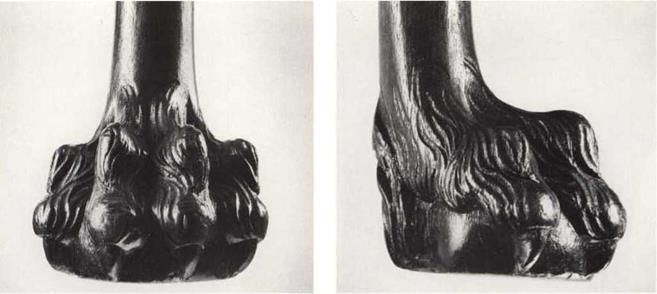 |
The Capitol Chair (fig. 46), paw foot. This foot is of the highest quality, showing an excellent understanding of anatomy and a masterful control of the medium.
68a. The Capitol Chair, side view ofpaw foot. This foot was produced by the geometric system used on the excavated leg (seefig. 66d).

69. Philadelphia Side Chair, leg and foot, circa 1110. Mahogany.
The Colonial Williamsburg Foundation (acc. no. 1914-680).
|
|
 69a. Philadelphia Side Chair, profile of foot. This example has a somewhat naive modelling of the side toe, and coarse, tassel-like hair.
69a. Philadelphia Side Chair, profile of foot. This example has a somewhat naive modelling of the side toe, and coarse, tassel-like hair.

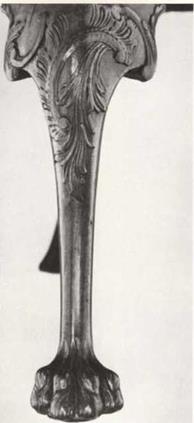
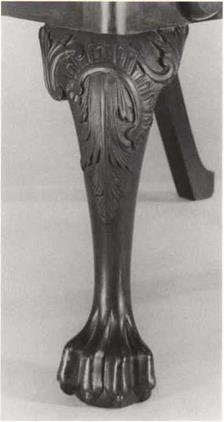

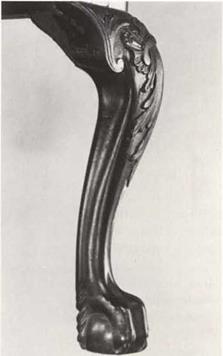
70. Fredericksburg Masonic Lodge Four Masters Chair (fig. 59), leg and foot.
|
|
70a. Lodge Four Master’s Chair, profile of foot showing severely vertical toes.
71. English Armchair, leg and foot, circa 1755. This piece represents English work of average quality.
Mahogany.
The Colonial Williamsburg Foundation (acc. no. G1965-194).
|
|
72. Williamsburg Masonic Lodge Six: Master’s Chair (fig. 47), leg and smooth paw foot.
72a. Ijulge Six Master’s Chair, profile of leg and smooth paw foot, showing an unusual fetlock ending with a small claw.
13. Clothespress, smooth pan foot, attributed
to the shop of Giles Grendey,
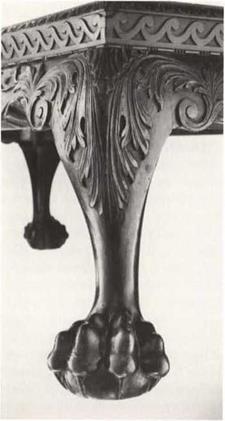 London, circa 1140.
London, circa 1140.
Mahogany.
The Colonial Williamsburg Foundation (acc. no. 1936-298).
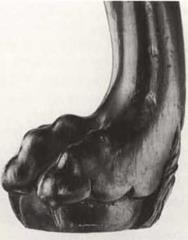


13a. Between the fetlock and front toes of this foot are highly developed pad segments, often seen on English pan feet. These are rare on American examples, and those found on the Capitol chair {jig. 61) are exceptional in this respect.
14. Irish Side Table, pan foot, circa 1160. With the exception of a smaller ball, some Massachusetts pan feet relate to this example, nith toes that are noticeably separated.
Mahogany.
The Colonial Williamsburg Foundation (acc. no. 1961-461).
14a. Irish Side Table, side vien of foot. The exaggerated fetlock shonn here is often seen on English pan feet.


